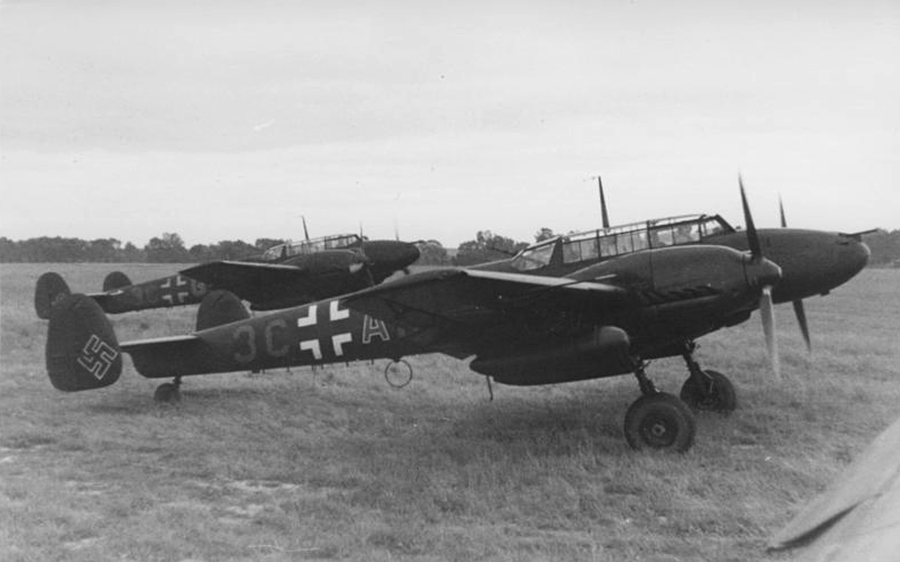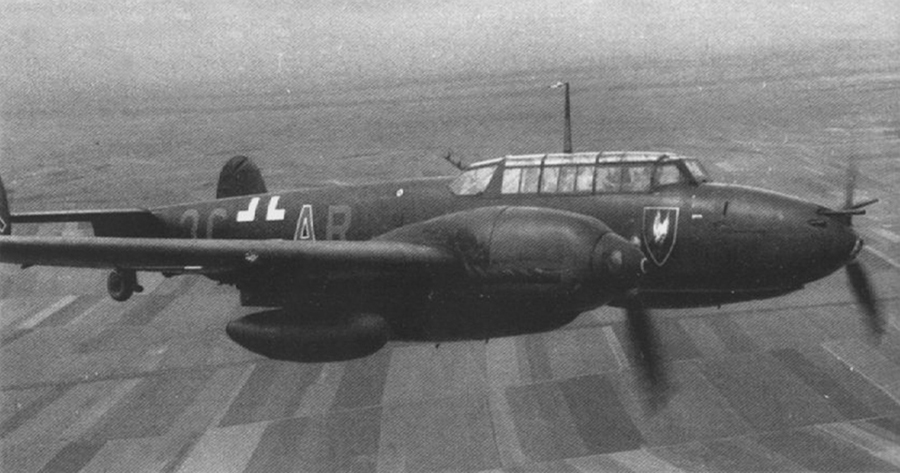Bf 110 3C+AR


This Bf 110, which belonged to 7./NJG 4, flew out of the German airfield at Mainz-Finthen in the summer of 1942. It is coded 3C+AR, the "3C" in front of the Balkenkreuz designating that the plane was part of Nachtjagdgeschwader 4, a night-fighter unit, and the letter "A" that it was flown by its Staffelkapitan. It is outlined in white, the color the Staffel to which it belonged and repeated, although barely discernable in the photograph, on the nose of the plane. The spinner tips, too, have a narrow white ring, which further aided in identification. The letter "R" identifies the plane as belonging to 7 Staffel, III Gruppe.

The Englandblitz badge so prominently displayed in this photograph is that of the Nachtjagdgeschwader, which was established in the summer of 1940. It derived from the family coat of arms of Hauptmann Wolfgang Falck (falke, "falcon" in German), Kommodore of its first unit, NJG1. As can be seen, the coding is a light gray, RLM 77 (hellgrau), and the identifying aircraft letter, which normally would be completely white, simply outlined in that color.
And this is how the plane has been profiled in the literature, although Breffort and Jouineau and Ward show the aircraft code in red (RLM 23, Rot). Even such an authority as Barry remarks that it was in red. The differences in shade is subtle, to be sure, but red is not the color of the Staffel to which the plane belonged. Nor does it accord with service regulation L.Dv. 521/1 that stipulated unit codes be over sprayed in RLM 77.
As to the Balkenkreuz, it "must be duly applied with washable marking colour 7120.77 without fail to night camouflage applied for night operations. The white angles of the Balkenkreuz will be omitted!" That the directive was so emphatic in emphasizing that the white angles of the Balkenkreuz not be obscured (as is apparent in the photograph) must have been to assure the plane's ready identification, even if it also risked detection by the enemy. The plane, itself, was to be painted in permanent RLM 22 Schwarz (7124.22). Both aviation lacquers were newly introduced in November 1941 with this regulation, the last two digits designating the shade—RLM 22, a permanent black, and RLM 77, a non-permanent gray (although no color chip was included with the regulation).

References: Messerschmitt's Twin-Engined Fighters from 1939 to 1945 (2009) by Dominique Breffort and André Jouineau (pp. 42, 51); Luftwaffe Colours 1935-1945 (2008) by Michael Ullmann (pp. 170, 316); German Night Fighter Aces of World War 2 (1998) by Jerry Scutts (p. 40); Nachtjäger: Luftwaffe Night Fighter Units, 1939-1943, Vol. I (2005) by David P. Williams (p. 67); The Messerschmitt Bf 110 in Color Profile 1939-1945 (2005) by John Vasco and Fernando Estanislau (p. 81); Messerschmitt Bf 110 C, D and E: An Illustrated Study (2008) by John Vasco and Fernando Estanislau (p. 148); Luftwaffe Codes, Markings & Units 1939-1945 (1995) by Barry C. Rosch (p. 315); Luftwaffe Colour Schemes & Markings, 1939-45: Mainly Winter Schemes (1974) by Richard Ward (n.p.).
![]()